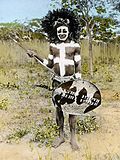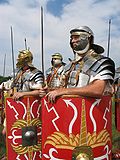Warrior
This article has multiple issues. Please help improve it or discuss these issues on the talk page. (Learn how and when to remove these messages)
|
| Part of a series on |
| War (outline) |
|---|
 |
A warrior is a guardian specializing in
History
Warriors seem to have been present in the earliest pre-state societies.
When the first hierarchical systems evolved 5000 years ago, the gap between the rulers and the ruled had increased. Making war to extend the outreach of their territories, rulers often forced men from lower orders of society into the military role. That had been the first use of professional soldiers, a distinct difference from the warrior communities.[5]
The warrior ethic in many societies later became the preserve of the
In contrast to the beliefs of the caste and clan-based warrior, who saw war as a place to attain
Inspired by the Ancient Greek ideals of the '
-
Samurai, member of the Japanese warrior caste
-
14th century knight Pippo Spano, member of the Order of the Dragon
-
Ottoman Mamluk warrior (circa 1550)
-
Recreation of a mounted warrior from the Mongol Empire.
-
Photograph of a Ngoni warrior with nguni shield c. 1895
-
A recreation of Roman legionaries wearing the lorica segmentata, 1st–3rd century
See also
- Endemic warfare
- Deadliest Warrior
- Feud
- Honour
- Martial races
- Soldier
- Warg
- Women warriors in literature and culture
References
- ISBN 978-0-7566-3203-8.
- ^ Gibbons, Ann (21 February 2017). "Thousands of horsemen may have swept into Bronze Age Europe, transforming the local population". Science.
- ^ Barras, Colin (27 March 2019). "Story of most murderous people of all time revealed in ancient DNA". New Scientist.
- ISBN 978-0-7566-3203-8.
- ISBN 978-0-7566-3203-8.
- ^ ISBN 978-0-7566-3203-8.
- ^ Harry D. Harootunian, "The progress of Japan and the Samurai class, 1868-1882." Pacific Historical Review (1959) 28#3: 255-266. online
- ISBN 978-0-7566-3203-8.
- Bradley C.S. Watson, "The Western Ethical Tradition and the Morality of the Warrior." Armed Forces & Society, October 1999; vol. 26: pp. 55-72; Samet, Elizabeth D., "Leaving No Warriors Behind: The Ancient Roots of a Modern Sensibility." Armed Forces & Society, July 2005; vol. 31: pp. 623-649; Miller, Laura L. and Charles Moskos, "Humanitarians or Warriors?: Race, Gender, and Combat Status in Operations Restore Hope." Armed Forces & Society, July 1995; vol. 21: pp. 615-637
Bibliography
- Ayvazyan A. "The Code of Honor of the Armenian Military (4-5th centuries)" (2000).
- Shannon E. French, Code of the Warrior - Exploring Warrior Values Past and Present (2003).






